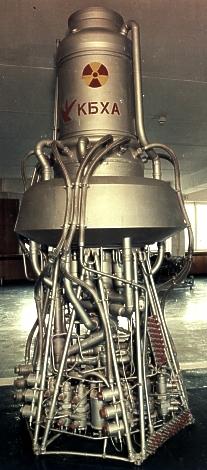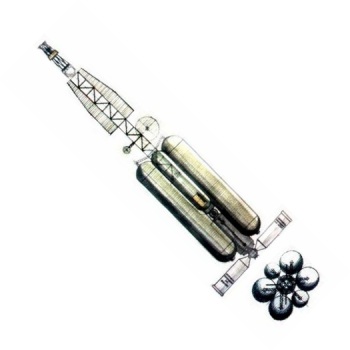 |
| http://www.cosmoworld.ru/spaceencyclopedia/programs/yard.jpg |
 |
| via Astronautix |
The history of American efforts to develop nuclear thermal
rockets is relatively well known. Similar Soviet efforts have remained far more
obscure. However, during the Cold War, the Soviet Union developed and tested an
advanced nuclear thermal rocket engine, designated the RD-0410. Unfortunately,
relatively little English-language information about the RD-0410 can be found
(at least in easily available sources).
Similar to the American NERVA program, development of Soviet
nuclear rocketry began in the mid-1950s. Serious research began in 1955, with
development of a rocket beginning in 1956 (the people working on this project
included such notable people as Kurchatov, Keldysh, and Korolev). Initially,
the Soviets planned to use the nuclear rocket to power an intercontinental
ballistic missile, or possible a cruise missile. However, it was quickly
realized that chemical rockets were good enough for suborbital flights. As a
result, by the 1960s, it was decided to develop the engine for usage in space.
The engine was developed by the KBKHA bureau, which had also
developed engines such as the RD-0105 (used on some derivatives of the R-7). The
goal was to develop an engine with a specific impulse of roughly 800-900
seconds, double what can be achieved with normal chemical rockets. Doing this
would require creating a nuclear reactor that was both very light, and capable
of withstanding very high temperatures around 3000 Kelvin. I have seen a few
references to a program to develop a 2,000 isp engine, but this would require
temperatures (over 15,000K) well in excess of what was possible in the 1950s
(or even today) for a solid core design.
The test site selected for the Soviet nuclear engine was
Semipalatinsk in Kazakhstan, a remote location similar to Jackass Flats in Nevada.
The Soviets had already tested numerous atomic weapons (including their first
in 1949 there), so the place was no stranger to nuclear activity. It appears
that tests of the engine were conducted in a mine shaft approximately 150
meters deep, unlike the American NERVA, which was tested aboveground. Most
likely, this was due to concerns over radiation should the engine malfunction.
At some point, the engine acquired the designation RD-0410, it is less commonly
known by its GRAU designation 11B91. That the engine received a GRAU
designation means that it was almost certainly considered for military
applications.
The American NERVA had a thrust of approximately 330
kilonewtons. This was much more than the RD-0410, which had about 35
kilonewtons. This was both by design, and due to political/monetary
considerations. The Soviet government had somewhat lost interest in the project
once it had become apparent that the nuclear engine was not usable as an ICBM
upper stage. More importantly, by developing a lower power engine, the reactor
assembly as a whole would be smaller. The RD-0410, including propellant, was
planned to mass roughly 15 tons when completed; putting it well within the
payload capabilities of Soviet launchers like Proton. The actual engine itself
weighed only about two tons. In contrast, the American NERVA was much heavier,
and could only be launched by a Saturn V or similar vehicle.
There were other important differences between NERVA and
RD-0410. The NERVA’s fuel elements were hexagonal in cross section, with
several holes drilled in them for hydrogen to pass through. Hundreds of these
elements (each about an inch wide) made up the NERVA’s reactor.
.png/623px-NERVA_fuel_element_configuration_(fr).png) |
| NERVA Fuel Elements |
It has been
difficult to find exact information about the geometry of the RD-0410’s fuel
rods, however, it appears that they had a complex shape. The fuel rods were
twisted, and had a complex cross section, shaped like the petals of a flower.
This was intended to lock the fuel rods together, and prevent fuel from falling
out of the reactor if a few rods cracked or became dislodged. The fuel elements
were made of uranium carbide, in order to better withstand the high
temperatures of the core.
Development and testing of the RD-0410 proceeded slowly. By
1973, America’s NERVA had already been test fired, then cancelled before
actually flying. However, large scale tests of the RD-0410’s components did not
begin until 1978. The test reactor was first started on March 27, 1978, and ran
for 70 seconds. Gradually, the reactor was run for longer, and at higher
temperatures. By 1981, the RD-0410 was running for an hour, its design
duration. A specific impulse of 910 seconds was achieved; this was superior to
that which was obtained with NERVA. The American Timberwind/SNTP project from
the late 1980s planned to achieve similar efficiency with much higher thrust to
weight, but it encountered numerous technical problems and did not reach the
test stage.
All accounts of the RD-0410 state that it’s testing at Semipalatinsk
went very well. Originally, it was planned that the engine would fly in 1985 (likely
replacing the Block D 4th stage on Proton). However, as the Soviet
Union imploded during the 1980s, development slowed, then halted. Other Soviet
nuclear rockets were planned, such as the RD-0411; a high thrust (~400 kN)
engine that would have been used on a Mars mission, and an engine designated
11B97, which would have had the capability of either nuclear thermal or
electric propulsion. However, like all other nuclear rocket programs, none of
them came to be.
 |
| via Astronautix, a concept for a Soviet Mars spacecraft, that likely would have used RD-0411 |
Bibliography:
http://www.cosmoworld.ru/spaceencyclopedia/programs/index.shtml?yard.html


.png/623px-NERVA_fuel_element_configuration_(fr).png)
